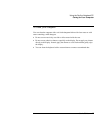
Using the Pavilion Notebook PC
Caring for Your Computer
46 User's Guide
•
Back up your work regularly. Copy files to floppy, tape or network drives.
•
Use a virus-scanning program, such as the included VirusScan, to check the integrity
of your files and operating system. Since new viruses appear frequently, you will also
want to update the program’s virus definitions from time to time; updates are on the
Web at www.networkassociates.com.
•
Check your disk using the scandisk utility.
To extend the life of the display
Observe the following guidelines to extend the life of the backlight in the computer
display.
•
When working at your desk, connect an external monitor and turn off the internal
display (Fn+F12).
•
If you are not using an external monitor, set the Turn off monitor timeouts (for both
AC and battery operation) to the shortest comfortable interval.
Note
There are two types of LCD display available when you buy your Pavilion Notebook
PC: HPA (high-performance addressing) and TFT (thin film transistor). HPA uses a
passive-matrix technology that produces better contrast than conventional LCD
displays. TFT, an active-matrix technology, is somewhat more expensive; it provides a
crisper, brighter display that is visible from a greater angle.
To get the most from your batteries
•
Do not leave batteries unused for long periods of time. If you have more than one,
rotate them.
•
If you normally use AC power, make a practice of at least once a week using the
battery as your power source.
•
Unplug the AC adapter when the computer is not in use.
•
To preserve the life of a battery, be sure to charge the battery regularly.
•
For long-term storage, the battery must be charged at 20–50% to minimize capacity
loss by self-discharge and to avoid deterioration of battery performance.


















